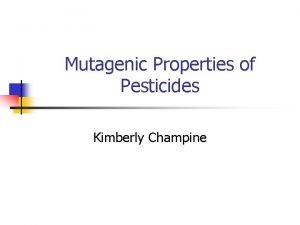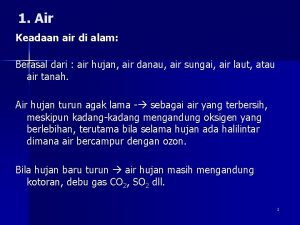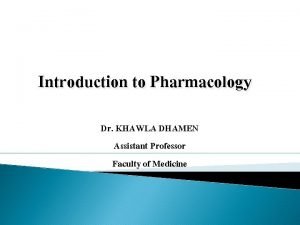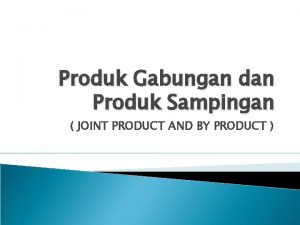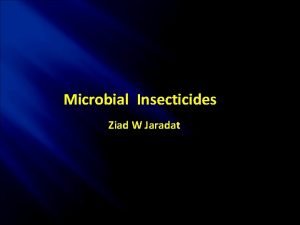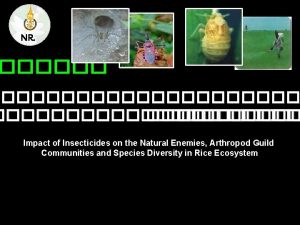Pyrethroid Insecticides Pyrethroid Insecticides Derived from natural product






















- Slides: 22

Pyrethroid Insecticides

Pyrethroid Insecticides • Derived from natural product -– Pyrethrum – Found in Chrysanthemum cinerarifolium • Synthetic pyrethroids – Variable in structure, toxicity – Generally benign environmentally • most are highly toxic to fish • Major uses in – Home and garden – Agriculture – Medical entomology

Natural Pyrethrum • Mixture of esters: – Chrysanthemic acid or pyrethric acid – + pyrethrolone, cinerolone, and/or jasmololone • Structural features essential for insecticidal activity: – 3 -C ring • Variables: – Enantiomers around asymmetric carbon atoms

ester Pyrethrin I: A+C = 10% Pyrethrin II: B+C = 9% Cinererin I: A+D = 2% acid Mix-and-match substituents Cinererin II B+D = 3% Jasmolin I: A+E = 1% Jasmolin II: B+E = 1% General structure of pyrethroid insecticides

Structural considerations • Contact with receptor must occur at 3 points • Isobutenyl moiety of acid • Dimethylcyclopentane ting • Unsaturated side chain of keto-alcohol


Steroisomers • Pyrethroids have several asymmetric carbon atoms. • Stereochemistry of these cabin atoms matters –Toxicity to insects varies with enantiomers

Synthetic pyrethroids • Objectives – Increase persistence • by decreasing insect inactivation • By decreasing photodegradation • By using synergists – Maintain – Level of insecticidal activity – Range of insects killed • Stages – 1 st generation • Varied R, R’ with alkyl and aryl substituents – 2 nd generation • Used Cl, Br, F • Last 4 -7 days on foliage in sunlight – 3 rd generation • Cyano group • Last up to 10 days • Applied at 0. 01 to 0. 05 lb/A

1 st generation 2 nd generation 3 rd generation

Toxicity of various pyrethroids * ** • *Registration cancelled 2004 • **Registration cancelled 1992

Systemic toxicity: Type I • Pyrethroids without cyano group • Target – CNS, • primarily brain stem • Cerebellum and cerebrum not primary targets – Progressive development of fine whole body tremor – Exaggerated startle reflex • • • Large increase in metabolic rate Uncoordinated twitching Hyperexcitability Hyperthermia Death results from metabolic exhaustion and hyperthermia

Systemic toxicity: Type II • Pyrethroids with cyano group • Target: – CNS – All regions affected • Symptoms complex – – – Salivation Rolling gait - increased extensor tone in hind limbs Spasms due to sensory stimuli Tonic seizures Apnea death

Allergic Reactions • Of topical exposure – Contact dermatitis • Either natural or synthetic pyrethroids – Irritant effect • Not inflammatory response • Lasts up to 24 hours • May include numbness or parasthesias – “Annoying but not disabling” – Apparently completely reversible • Systemic allergic responses – Pyrethroids derive from chrysanthemum components – Allergies are well known to occur • • Respiratory May be serious Rarely, fatal Occupational exposure ---> emphysema (rare? )

Cellular Toxicity • • Insecticidal activity: – Prolong opening of voltage-gated sodium channels Mammalian toxicity – Sodium channels • Variable, depending on isoform – Some voltage-gated calcium channels – Some voltage-gated chloride channels – Peripheral-type benzodiazepene receptors • Contributing to convulsive effects • Variations of effects on ion channels: – Pyrethroids have high affinity for active membrane Na+ channels • Only affect open channels, blocking them – “Open channel blockers” – Pyrethroids without alpha-cyano group • Cause nerve channels to close very slowly – Pyrethroids with alpha-cyano group (4 th generation) • Cause delayed closure of Na channels

Transmembrane channels • • • Formed by proteins Hydrophilic channels through the lipid membrane May be permanently open May be gated: normally closed, open for cause Gates respond to • Ligands • Electrical charge • Gates may close rapidly after opening, even if signal is still being given • Example: neuromuscular junction – Electric nerve impulse reaches nerve terminal


Neuromuscular junction • Signal: electrical – Depolarization of nerve impulse – Decrease in membrane polarization opens voltage-gated Ca+ channels in presynaptic membrane – Ca+ ions stream into cell, triggering release of ACh • ACh receptors are ligand-gated – Transiently permeable to Na+ and K+ in presence of ACh


Gated transmembrane channels: presynaptic terminal – At terminal of axon: • • Depolarization opens voltage-gated Ca+2 channel Responds to nerve impulse Releases Ca+2 into axon terminal Causes ACh release into synaptic cleft

Degradation of pyrethroids • Photolytic – Very rapid for pyrethrum, early pyrethroids • Metabolic – – Extremely rapid for pyrethrum, early pyrethroids Less rapid for later generations of synthetics Mediated by P 450 s Inhibited by synergists • Piperonyl butoxide

Piperonyl butoxide • LD 50 = > 7500 mg/kg, rats, po • Inhibits cytochromes P 450 • Synergizes – Pyrethroids – Some OPs, carbamates

Ecotoxicology of Pyrethroids • Extremely toxic to fish • Mammalian toxicity – Minimal for most pyrethroids – Exceptions • Deltamethrin, 25 -60 mg/kg • Flucythrinate, 53 -87 mg/kg • Natural pyrethroids – Benign except for toxicity to fish • Synthetic pyrethroids – Increased persistence not of an order to raise concern about bioaccumulation – Movement into water from terrestrial applications is a danger with more persistent pyrethroids • Low application rates minimize this
 Pyrethroid poisoning
Pyrethroid poisoning Pesticides classification
Pesticides classification What is the state of water
What is the state of water Natural hazards vs natural disasters
Natural hazards vs natural disasters Natural capital and natural income
Natural capital and natural income Khawla natural product
Khawla natural product Tourism product definition
Tourism product definition Natural health product licensing canada
Natural health product licensing canada Relationship between total average and marginal product
Relationship between total average and marginal product Product line depth
Product line depth What is industry/target market feasibility analysis
What is industry/target market feasibility analysis Perbedaan cross product dan dot product
Perbedaan cross product dan dot product Product line and product depth
Product line and product depth Perkalian cross vektor i j
Perkalian cross vektor i j New product development and product life cycle strategies
New product development and product life cycle strategies Domestic product and national product
Domestic product and national product Mkt 600
Mkt 600 Core actual and augmented product
Core actual and augmented product Produk gabungan
Produk gabungan Dot cross product
Dot cross product Product range vs product mix
Product range vs product mix Fundamental and derived positions
Fundamental and derived positions Mosby items and derived items
Mosby items and derived items

